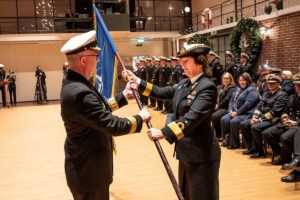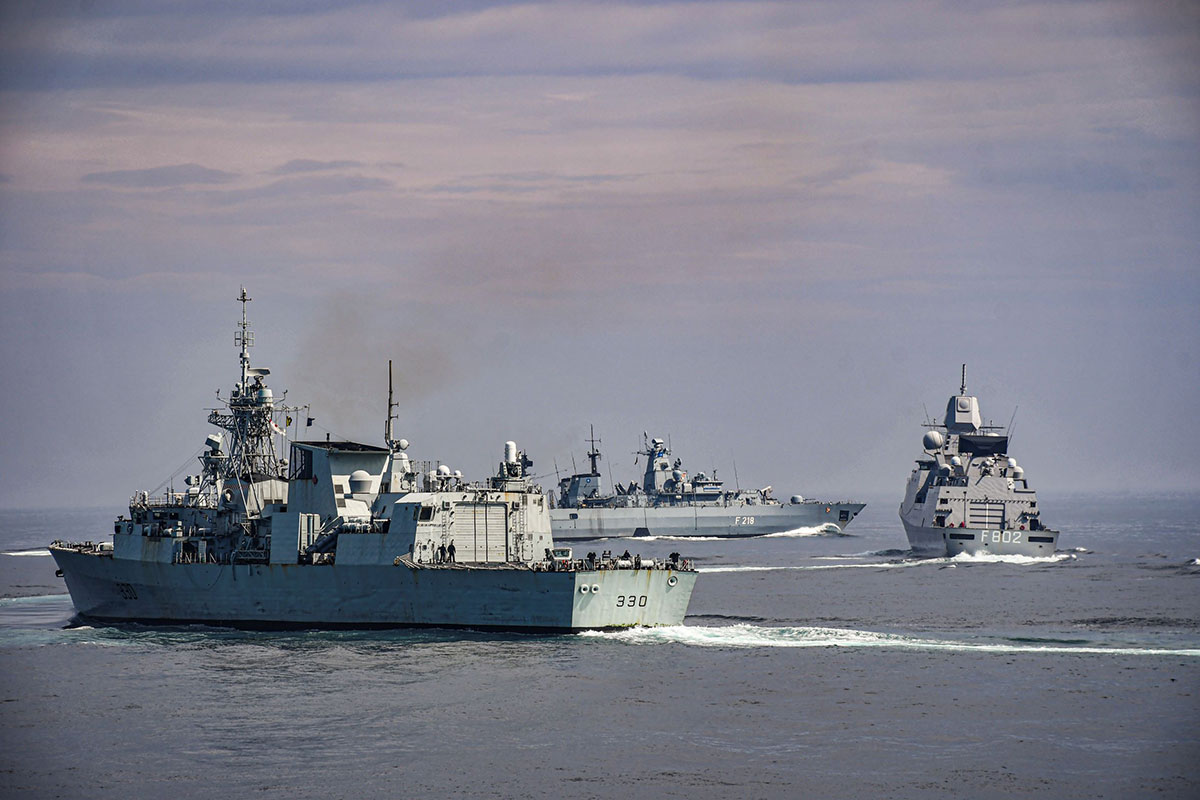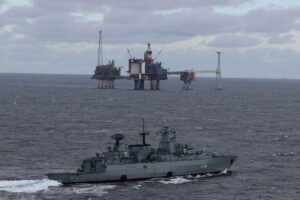"Not during our watch!" was the decisive reaction of the inspector of the navy to the invasion of Ukraine by Russia in violation of international law. What does this mean in concrete terms for those on watch on board?
Just a few days after the turn of the year, the frigate Mecklenburg-Vorpommern travelled to take part in Task Group 441.01, the Very High Readiness Joint Task Force (Maritime), or VJTF (M) for short, for the third time. Strictly speaking, this is only a mission-equivalent obligation, but against the background of the current security situation in Europe, it is nevertheless equivalent to a deployment.
Through its presence in the northern flank area, the permanent NATO Response Force combat unit is intended to contribute to alliance solidarity and reassurance, while demonstrating operational readiness by participating in various high-value manoeuvres also serves as a military deterrent. The special feature this time is that the frigate Mecklenburg-Vorpommern has been the flagship of the permanent NATO task group since Flotilla Admiral Thorsten Marx took command of Task Group 441.01. This means that the leadership role of a significant part of the VJTF Maritime has been transferred to the German Navy.
The Standing Naval Force Atlantic (SNFL) and its successor, the Standing NATO (Response Force) Maritime Group (SNMG1), are widely known. But what are the differences to the VJTF (M), which still appears to the outside world as SNMG 1? First of all, following Russia's attack on Ukraine and the activation of the VJTF by the Supreme Allied Commander Europe, SNMG1 became Task Group (TG) 441.01 of the VJTF(M) in organisational terms.
After years of focussing on international crisis management missions, the main difference to SNMG 1 is the regained size and therefore effectiveness of the unit, which operates at a consistently high tempo that is defined by a dynamic and flexible training and deployment plan. In particular, large-scale manoeuvres such as Dynamic Mongoose in the strategically important sea area between Greenland, Iceland, Great Britain and Norway, the so-called GIUKN Gap, demonstrate the Alliance's ability to secure its own supply routes across the Atlantic in the event of a conflict using a realistic threat scenario and are also used in this sense for NATO's strategic communication with the outside world.
The will of all NATO member states to show unity and strength is enormous, the message clear: NATO is always ready to fight and the VJTF (M) is the cold-start spearhead that the alliance deploys wherever there is an acute need. This was the case in the immediate aftermath of the explosions on the Nord Stream pipeline in September last year, when units from the task group were deployed at short notice to monitor critical infrastructure. While the "old" SNMG1 followed a "timetable" that was known more than twelve months in advance, this change in mindset means that the NATO Maritime Command (Marcom), based in Northwood in the UK, now only plans for TG 441.01 in a twelve-week cycle and is not afraid to cancel the rest periods in port that are usually scheduled in the summer and over the turn of the year without replacement.

Probation within the association framework
On 24 February, all available units of the German Navy were sent to the North and Baltic Seas under the motto "Not during our watch". At this time, the Mecklenburg-Vorpommern was on its way back to its home port after German Operational Sea Training (GOST GEA) was aborted due to the pandemic and was scheduled to deploy to the Mediterranean for Eunavformed Operation Irini without a fully completed operational training programme. Under the impact of the Russian attack on Ukraine, this plan was revised just a few days later and, after a short regeneration phase and the subsequent Isex, the crew was placed in ten days of isolated individual accommodation to prevent a renewed coronavirus outbreak, after which they completed their operational training by achieving the Bravo (combat ready) level.
At the end of May, the Mecklenburg-Vorpommern then replaced the corvette Erfurt in TG 441.01. The high level of training and the operational tempo were noticeable from the very first encounter with the unit, which at the time consisted of four frigates, a dock landing ship and the fuel transporter Spessart. However, thanks to the structures and processes created in the EAP, the integration into TG 441.01 went smoothly and quickly after a brief "shake-up".
The operational tempo did not change over the next seven weeks. Among other things, the unit took part in the major submarine hunting manoeuvre Dynamic Mongoose 2022. Ten ships, three submarines, seven Maritime Patrol Aircraft (MPA) and embarked helicopters from eleven nations were involved in exercises lasting up to 36 hours. In addition to maritime surveillance as a permanent mission, two to three operational exercises per day were planned during the break periods.
In naval terms, towing and sea supply manoeuvres were also on the agenda, which were sometimes ordered unannounced from a 30-minute standby. In addition, navigation instruction voyages around the Faroe Islands or in the Norwegian fjords, some of which were completed under asymmetric threat scenarios, created lasting impressions. After its first participation in the VJTF (M), which lasted until mid-July 2022, the frigate completed a total of 267 serials in seven weeks, including 20 major operational exercises and twelve supply manoeuvres with almost daily flight operations.
After a short summer holiday, Mecklenburg-Vorpommern took part in the VJTF(M) again in September and October. The units took part in the large-scale manoeuvres Dynamic Messenger and Joint Warrior as well as the national projects Heimdall and Vision in autumn. An NBC defence capability check in the home port concluded the year.
Since 4 January, the Mecklenburg-Vorpommern has once again been deployed as the flagship in TG 441.01 until mid-July 2023.

What remains of the participation in the VJTF (M) and what needs to be considered in the future?
Even though the ship still had more than four months of operation ahead of it at the time of writing, it is already possible to draw some preliminary conclusions.
On the one hand, it should be noted that the VJTF(M) gives the units an opportunity to practice essential skills for national and alliance defence in the area of multidimensional naval warfare against an equivalent opponent in a unit framework with our allies, even outside of German Operational Sea Training over a longer period of time. Particularly in the operational area, it is clear that the GOST is not the end, but the beginning of training in the organisation in order to be able to master the military craft at all times under all circumstances. It is also positive to note that an operational training programme completed with the operational readiness level Bravo enables a crew to operate successfully in this operational environment. The Mecklenburg-Vorpommern has also proven that the German Navy can lead multinational formations and has mastered the necessary procedures in the various warfare areas. This became clear, for example, during numerous submarine hunting exercises in which the ship led several Maritime Patrol Helicopters, MPAs and Towed Array Sonar carriers in a tactical scenario against a submarine. Furthermore, there is no reason to hide behind the partners in terms of technical readiness. The rapid delivery of spare parts, including the availability of technical support from the naval arsenal in the event of sensor and effector faults, was exemplary in comparison with the ships of other nations. The delivery of a Lynx engine to the Faroe Islands and the subsequent repair within 48 hours of the defect being identified also impressed the Dutch commander.

So everything is fine? Unfortunately not, because apart from these success stories, the deployment of the Mecklenburg-Vorpommern also revealed some weaknesses that need to be rectified. For example, it has become clear in the association what we did not do sufficiently during our time as individual drivers in the Mediterranean and the Horn of Africa. Specifically, this includes aspects such as the nationwide operation of Link 16 networks and the operational use of Link 22 as well as sufficient bandwidth in times of rapid information exchange. This also includes modern systems in the individual warfare areas, such as the use of unmanned systems and the introduction of modern equipment, such as a towed array system for sub-hunting or "simple" things like the timely equipping of IFF Mode 5. Even if we are in a position to manage corresponding assets in the organisation, it has become clear that we ourselves can only make a small contribution here. This leaves us with the realisation that there is undoubtedly a need for modernisation in many areas so that we can continue to operate on an equal footing with our allies in the future. Another challenge that will remain in the foreseeable future is the availability of personnel. Three VJTF (M) participations within twelve months with a correspondingly high tempo following an EAP completed under pandemic conditions are pushing a crew suffering from considerable vacancies, particularly in the area of operational personnel, to the limits of its resilience despite all the pride. Only the unconditional will to persevere and the right mindset make this possible. Nevertheless, the recruitment of new personnel who are able and willing to go to sea plays a decisive role.
As echoed in Chancellor Olaf Scholz's turnaround speech, the new mindset of national and alliance defence, of "being able to fight so as not to have to fight" must be in everyone's minds. In addition to the crews, this also applies to the rear areas of maintenance, logistics, personnel and training, which must act in accordance with the motto "frontline first". The prerequisite for this is a cross-sectional operational understanding and corresponding prioritisation throughout the entire navy and the Bundeswehr, including logistical support and personnel management. If the aforementioned challenges in the areas of technical modernisation, adequate staffing and operational mindset can be successfully resolved, we can look to the future with optimism once again.
Kapitänleutnant Lisa Becker and Kapitänleutnant Pascal Heimann are crew members of the frigate Mecklenburg-Vorpommern.
Lisa Becker and Pascal Heimann








